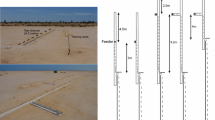Summary
-
1.
This study begins to evaluate how octopuses navigate, and whether they can use visual landmarks. Paths ofOctopus vulgaris were observed in the field as they foraged and responded to displacements.Octopus rubescens were trained to orient to a beacon in the laboratory, and response to its displacement was monitored.
-
2.
Octopuses foraged using chemotactile exploration but did not retrace their outgoing paths.
-
3.
Octopuses learned to orient to a beacon for a food reward, and oriented directly to it when it was moved 90° each day.
-
4.
When a three-landmark array was presented to one octopus it oriented first to the largest landmark, then to the beacon. It responded to movement of one or more landmarks suggesting both orienting to this conspicuous landmark and going to where the beacon ought to have been.
-
5.
The lack of disruption of octopuses' return home in the field by movement of an artificial landmark, the significant prediction of whether they would eat away from home by distance from the home, and their ease of return home when they were displaced by territorial fish, in combination with the lab data, suggested that octopuses can and do use a long-term memory of a visual landmark array.
Similar content being viewed by others
References
Arey LB, Crozier WJ (1918) The homing habits of the pulmonate molluskOnchidium. Proc Natl Acad Sci USA 4:319–321
Cartwright BA, Collett TS (1983) Landmark learning in bees. J Comp Physiol 151:521–54
Chelazzi G, Focardi S, Deneubourg JL (1983a) A comparative study on the movement patterns of two sympatric tropical chitons (Mollusca: Polyplacophora). Mar Biol 74:115–125
Chelazzi G, Innocenti R, DellaSantina P (1983b) Zonal migration and trail-following of an intertidal gastropod analyzed by LED tracking in the field. Mar Beh Physiol 10:121–136
Chelazzi G, Della Santini P, Vannini M (1985) Long-lasting substrate marking in the collective homing of the gastropodNerita textilis. Biol Bull 168:214–221
Cheng K (1988) Some psychophysics of the pigeon's use of landmarks. J Comp Physiol A 162:815–826
Cheng K, Collett TS, Pickhard A, Wehner R (1987) The use of visual landmarks by honeybees: bees weigh landmarks according to their distance from the goal. J Comp Physiol A 161:469–475
Collett TS, Cartwright BA, Smith BA (1986) Landmark learning and visuo-spatial memories in gerbils. J Comp Physiol A 158:835–851
Cook A (1977) Mucus trail following by the slugLimax grossui Lupu. Anim Behav 25:774–781
Cook A, Bamford OS, Freeman JDB, Teideman DJ (1969) A study of the homing habit of the limpet. Anim Beh 17:330–339
Cook SB, Cook CB (1975) Directionality in the trail-following response of the pulmonate limpetSiphonaria alternata. Mar Beh Physiol 3:147–155
Etienne AS, Maurer R, Saucy F (1988) Limitations in the assessment of path dependent information. Behav 106:81–111
Etienne AS, Teroni E, Hurni C, Partenier V (1990) The effect of a single light cue on homing behaviour of the golden hamster. Anim Beh 39:17–41
Graziadei PPC, Gagne HT (1976) Sensory innervation in the rim of the octopus sucker. J Morphol 150:639–680
Hamilton PV, Russell BJ (1982) Field experiments on the sense organs and directional cues involved in offshore-oriented swimming byAplysia brasiliana Rang (Mollusca: Gastropoda). J Exp Mar Biol Ecol 56:123–143
Hartwick EB, Ambrose RF, Robinson S (1984) Den utilization and the movements of taggedOctopus dofleini. Mar Beh Physiol 11:95–110
Lima SL, Valone TJ, Caraco T (1985) Foraging efficiency — predation risk trade-off in the grey squirrel. Anim Beh 33:155–164
Maldonaldo H (1964) The control of attack byOctopus. Z Vergl Physiol 47:656–674
Mather JA (1980) Social organization and use of space byOctopus joubini in a semi-natural situation. Bull Mar Sci 30:848–857
Mather JA (1988) Daytime activity of juvenileOctopus vulgaris in Bermuda. Malacologia 29:69–76
Mather JA (1991) Foraging, feeding, and prey remains in middens of juvenileOctopus vulgaris. J Zool (Lond) (in press)
Mather JA (1991) Interactions of juvenileOctopus vulgaris with scavenging and territorial fishes. Manuscript in submission
Mather JA, O'Dor RK (1991) Foraging, energetics, movement patterns and the life history of juvenileOctopus vulgaris. Bull Mar Sci (in press)
Mather JA, Resler S, Cosgrove J (1985) Activity and movement ofOctopus dofleini. Mar Beh Physiol 11:301–314
Olton DS, Samuelson RJ (1976) Remembrance of places passed: Spatial memory in rats. J Exp Psychol Anim Beh Proc 2:97–116
Paine RT (1963) Food recognition and predation on opisthobranchs byNavanax inermis. Veliger 6:1–9
Phelps MT, Roberts WA (1989) Central-place foraging byRattus norvegicus on a radial maze. J Comp Psychol 103:326–338
Roberts WA (1988) Foraging and spatial memory in pigeons. J Comp Psychol 102:108–117
Spetch ML, Edwards CA (1988) Pigeons',Columba livia, use of global and local cues for spatial memory. Anim Behav 36:293–296
Tankersley RA (1990) Trail following inLittorina irrorata: the influence of visual stimuli and the possible role of tracking in orientation. Veliger 33:116–123
Tinbergen N (1972a) On the orientation of the digger waspPhilanthus triangulum Fabr. I. In: Tinbergen N: The animal in its world, vol 1: Field studies. Allan & Unwin, New York, pp 103–127
Tinbergen N (1972b) On the orientation of the digger waspPhilanthus triangulum Fabr. III. Selective learning of landmarks. In: Tinbergen N: The animal in its world, vol. 1: Field studies. Allan & Unwin, New York, pp 146–196
Trott TJ, Dimock RV Jr. (1978) Intraspecific trail following by mud snailIlyanassa obsoleta. Mar Behav Physiol 5:91–101
Wehner R, Raber F (1979) Visual spatial memory in desert antsCataglyphis bicolor (Hymenoptera: Formicidae). Experientia 35:1569–1571
Wells MJ (1978) Octopus: Physiology and behaviour of an advanced invertebrate. Halstead, London
Wilson ED (1971) The insect societies. Belknap, Cambridge
Author information
Authors and Affiliations
Rights and permissions
About this article
Cite this article
Mather, J.A. Navigation by spatial memory and use of visual landmarks in octopuses. J Comp Physiol A 168, 491–497 (1991). https://doi.org/10.1007/BF00199609
Accepted:
Issue Date:
DOI: https://doi.org/10.1007/BF00199609




